Introducing the World's First L4 Intelligent Agent Mother System: MasterAgent
![]() 07/30 2025
07/30 2025
![]() 641
641
This March, Manus burst onto the scene, propelling "intelligent agents" from tech circles into the public eye overnight. Despite Manus's subsequent move to Singapore and complete exit from the Chinese market, "intelligent agents" have become the focal point in the AI world: constant industry funding news, tech giants like Google, OpenAI, ByteDance, Baidu, and Alibaba piling in, and intelligent agents being one of the hottest topics at the recently concluded 2025 World Artificial Intelligence Conference (WAIC). All these indicators suggest that 2025 has truly ushered in the "Year One of Intelligent Agents".
As a super app in the AI era, intelligent agents serve as a bridge connecting large models from the informational entry point of "I ask, AI answers" to the execution terminal of "I say, AI does". They are the core application form that unleashes the value of AI technology. Through intelligent agents, users genuinely perceive AI as more than just a chatbot but a capable assistant. Simultaneously, the wave of intelligent agents is accelerating its spread to finance, healthcare, government services, manufacturing, education, and various other industries. A systemic revolution to "get AI moving" has already commenced.
After experiencing numerous "single intelligent agents," I recently encountered an intelligent agent system with even greater potential than Manus: MasterAgent, the world's first L4 intelligent agent mother system. It can directly "generate" an intelligent agent team, possesses fully autonomous decision-making technology to allow different intelligent agents to coordinate autonomously, and allows me to modify/customize each intelligent agent. This once again redefines the form and upper limit of AI intelligent agents.
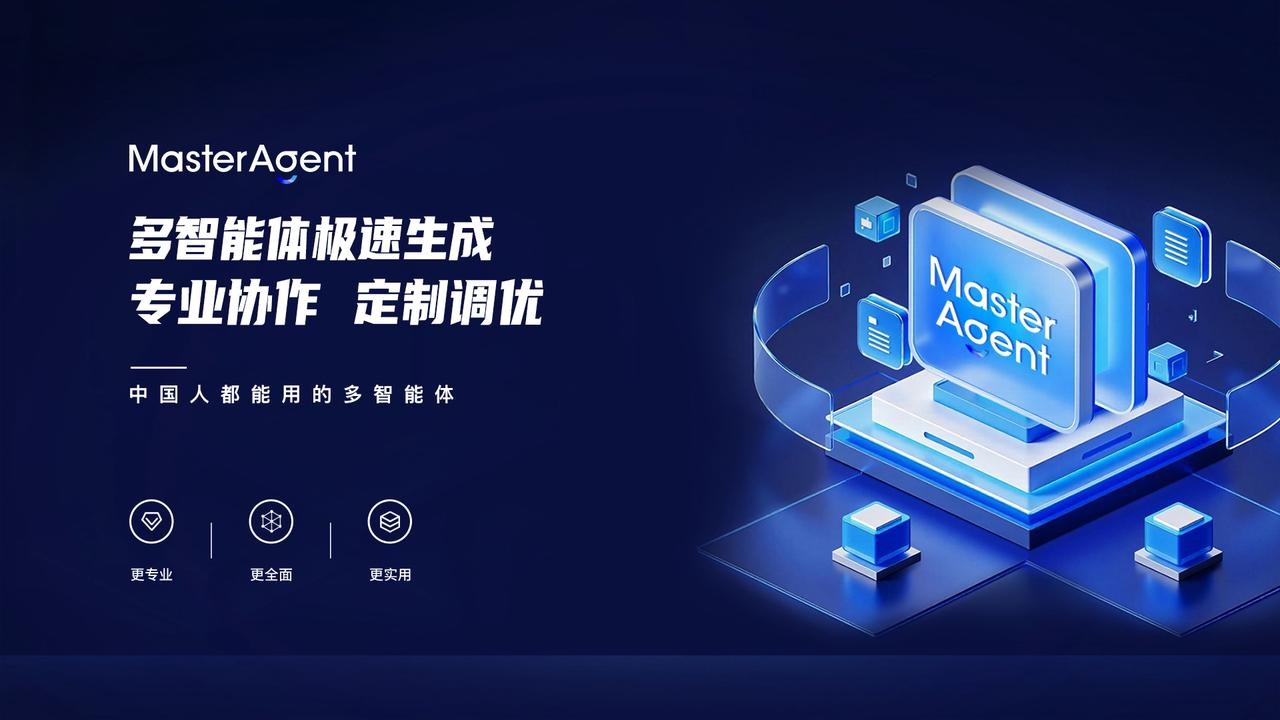
Unlike most "intelligent agent" products that are merely applied at the "scheduling tool" level, MasterAgent has pioneered the ability to "generate a multi-agent team with one sentence." From a positioning standpoint, it is neither a "single intelligent agent" nor a "single intelligent agent" like Manus that can call upon third-party intelligent agents. Rather, it is an AI system that can generate multiple intelligent agents and form a team, or an "intelligent agent mother system" with generative, organizational, and executive capabilities.
In practical scenarios, I only need to input a sentence of natural language, and MasterAgent can complete the initial construction of the team within minutes. It can analyze requirements, break down tasks, create multiple intelligent agents, and configure their respective roles and responsibilities. Unlike other intelligent agents like Button, MasterAgent doesn't require me to write a single line of code or perform complex configurations, nor do I need to understand the underlying logic of how intelligent agents operate. It automatically matches the required capabilities to generate a professionally structured multi-agent cluster. Overall, MasterAgent has a low learning curve but delivers high professionalism, already ahead of intelligent agent products on the domestic market.
For instance, my requirement is: "Assemble a due diligence team capable of conducting rapid and comprehensive fundamental analysis on potential investment targets (startups) and generating a structured draft investment memorandum."
Comparison of results from three platforms:
MasterAgent:
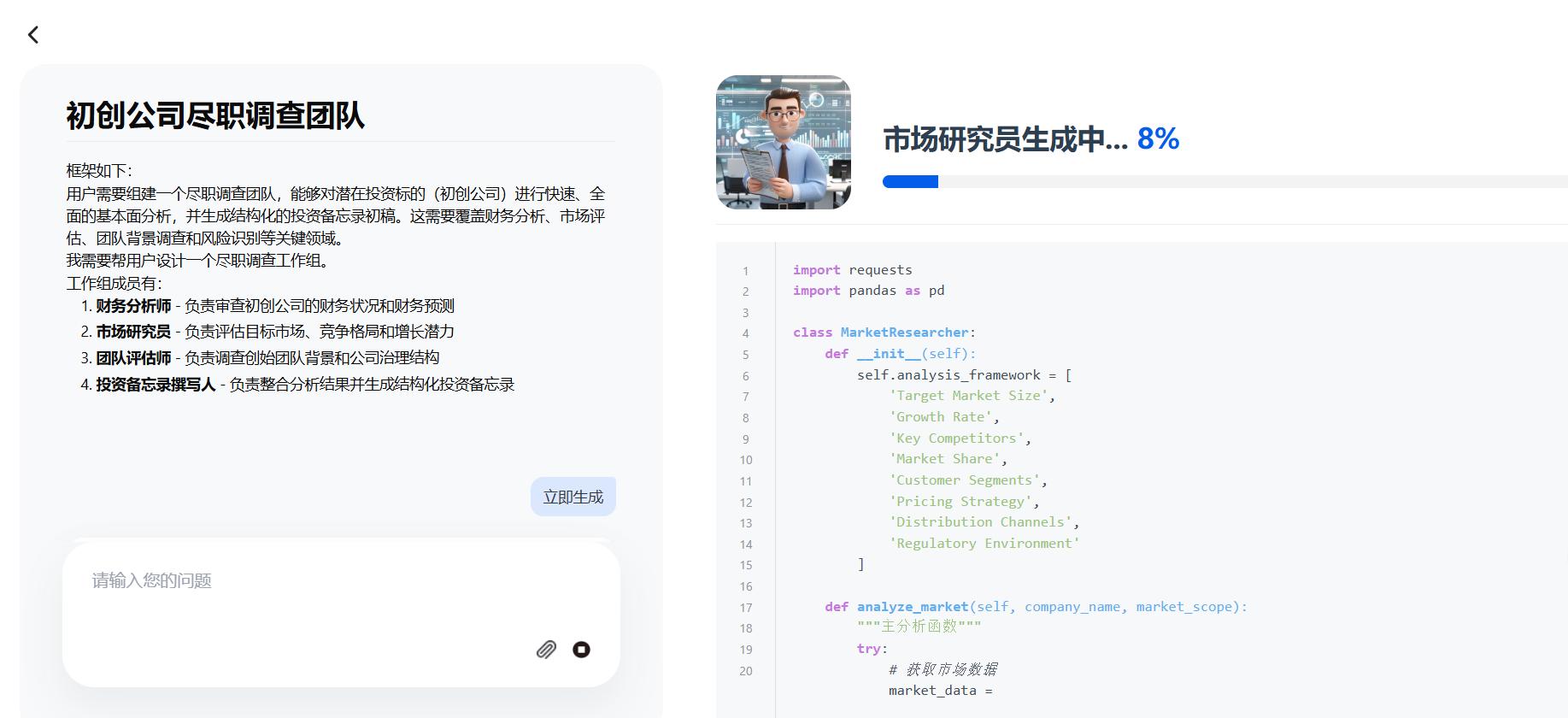
Doubao:
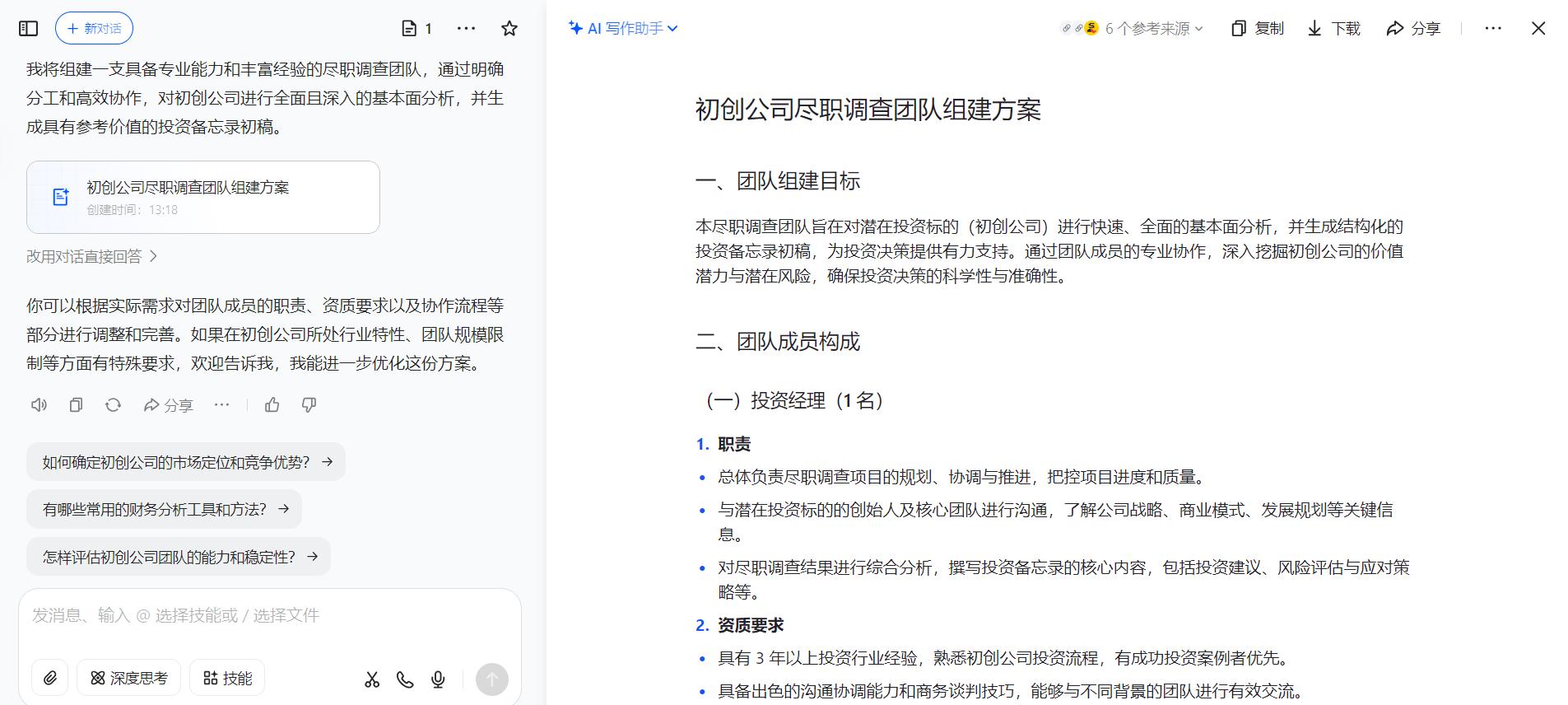
Yuanbao:
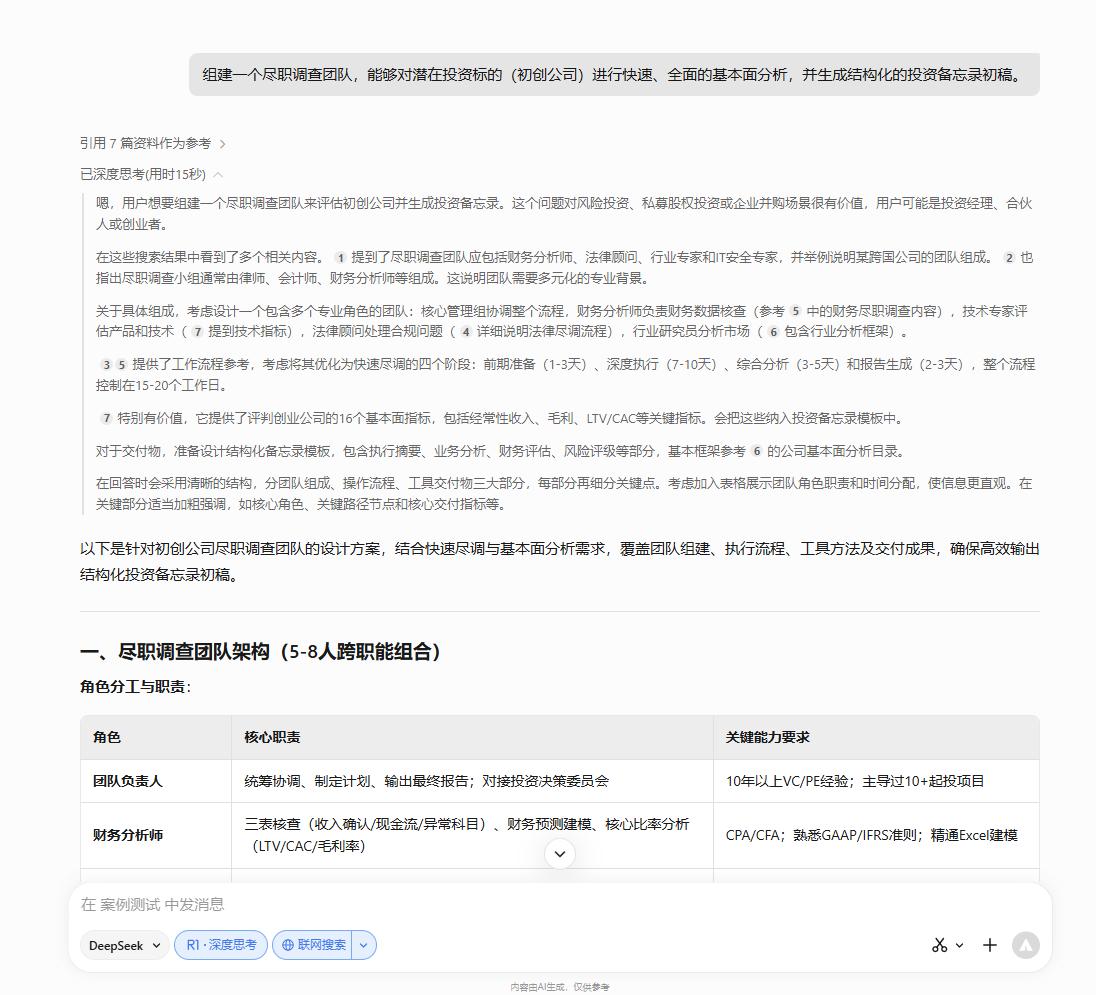
After inputting the instruction, MasterAgent generates an "investment due diligence intelligent agent team" consisting of investment manager intelligent agents, financial analyst intelligent agents, industry and technology researcher intelligent agents, and background and risk examiner intelligent agents.
Similarly, with just one sentence, you can generate a content team with creative capabilities, a PR team to handle public opinion crises... You don't even need to think about what professional roles a team actually needs.
After generating the intelligent agent cluster, MasterAgent allows me to highly customize each intelligent agent.
If I want to adjust the capabilities of a single intelligent agent within the "team" or endow it with certain characteristics, I can perform "deep customization" individually – supporting prompt word adjustments, plugin adjustments, and knowledge base adjustments. Of course, this only requires me to propose more detailed requirements or endow characteristics through natural language.
If I discover that a particular team lacks an intelligent agent for a specific role, I can separately generate the corresponding single intelligent agent and then pull it into the "team." There is no upper limit to the number of single intelligent agents that can be added for collaboration, further enhancing the professional capabilities and output effects of the multi-agent cluster – all without any coding required.
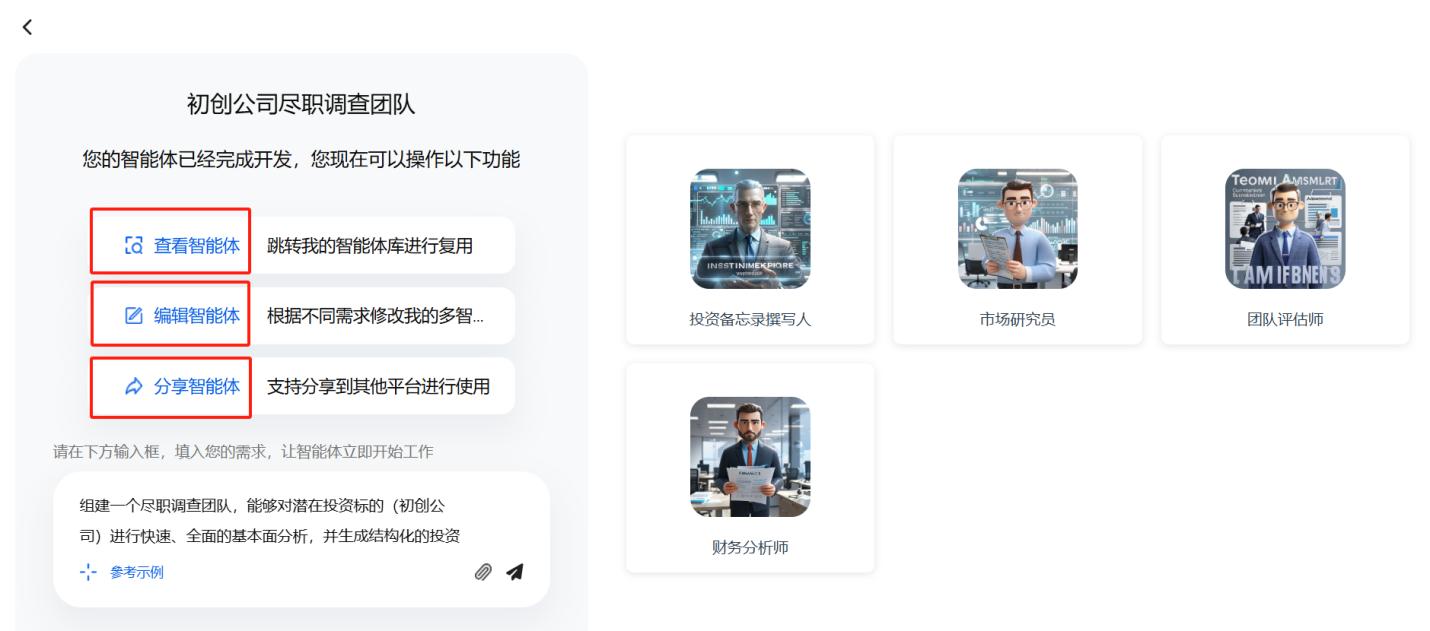
The process of generating intelligent agents with MasterAgent is akin to forming a startup team. In the past, when starting a business, I had to consider project positioning, market demand, product characteristics, and also needed to raise funds, recruit people, rent offices, develop... Now, when I have an idea, I can immediately use MasterAgent to "gather people to work" and form an intelligent agent team capable of completing specific complex tasks.
Most importantly, the intelligent agent cluster generated by MasterAgent is not a "makeshift team." These agents are not isolated from each other but form a professional team that can collaborate. They can share information and data, call upon each other's results, be organized, scheduled, and trained, and autonomously and smoothly complete complex tasks like an assembly line, achieving full automation without human intervention.
In summary, MasterAgent can directly generate an "intelligent agent dream team" similar to one composed of multiple Manus each fulfilling their respective duties. Each intelligent agent can be customized for specific scenarios and tasks, making it more professional, comprehensive, and practical compared to Manus.
Taking Shenzhen Shenyuan AI Technology Co., Ltd., the company behind MasterAgent, as an example, the "investment due diligence intelligent agent team" will conduct requirement analysis, task breakdown, multi-agent generation, and task allocation after receiving task requirements. Then, it will conduct research in the order of information collection, situation analysis, prospect assessment, risk identification, and integrated analysis to form a final investment evaluation report.
From the results, the investment evaluation report generated by the "investment due diligence intelligent agent team" is not only comprehensive and detailed but also far more accurate than expected, even uncovering the "post-95s team from the University of Science and Technology of China" behind the development of MasterAgent, which is undoubtedly critical information for investment investigations. Simultaneously, when it comes to information such as "valuation" for which no public data exists, MasterAgent does not hallucinate and "make things up" but frankly states "not found," while also providing the valuation of its AI-related startups as a reference. Based on the investment evaluation report, I can also simultaneously request it to generate PPTs and webpages with one click, facilitating subsequent internal reports, external sharing, or roadshow presentations.
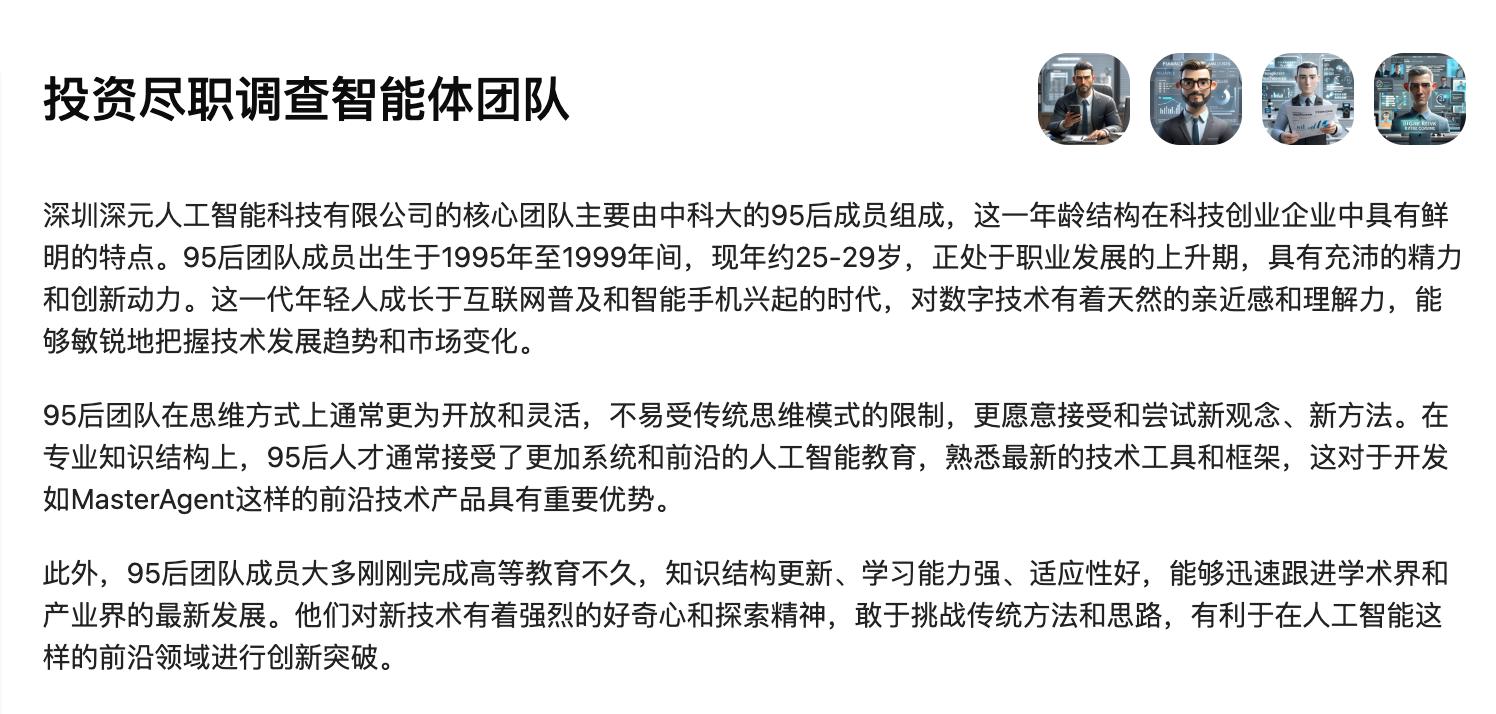
Not only that, but MasterAgent can also complete multiple tasks simultaneously. For example, after generating a "rapid response PR and public opinion team," if I ask it to handle a public opinion crisis for a certain brand, it will generate a complete response plan based on a comprehensive understanding of the latest situation and communication path, including responses on the official Weibo account, media press releases, internal Q&A guidelines for the customer service team, and media communication email templates. I feel that brands like Romoss, which have encountered crises, can directly use these.
On platforms like coze and manus for single intelligent agents, I often need to customize N intelligent agents or use N intelligent agent platforms for multiple rounds of communication and combine the results to achieve similar goals. But now with MasterAgent, I only need to use one instruction, wait a few minutes for generation, and then perform a small amount of configuration to achieve "AI project collaboration" and complete tasks in one go. The value of MasterAgent is not just saving me one or a few people but providing me with an entire "multi-agent expert team" that understands cooperation, can communicate, and can be trained. Together, they strive to complete the complex tasks combining the multiple individual tasks I assign – this is precisely one of the characteristics of MasterAgent as the world's first "L4 intelligent agent mother system."
From "getting AI to work" to "getting AI to work in teams," MasterAgent's leap forward is a true generational upgrade in the development of intelligent agents.
Since DeepSeek significantly reduced the cost of AI application implementation, the entire AI industry has been transitioning from "chat" to "action." With the evolution of model reasoning capabilities and the expansion of application scenarios, an increasing number of industry insiders have reached a consensus: intelligent agents (Agents) are the ultimate application form in the AI era, equivalent to Apps in the mobile era. Due to the emergence of intelligent agents, AI will no longer be limited to providing "information services" such as generating text/images/videos but will possess more complex task collaboration and real-world execution capabilities.
This trend has been evident in the past six months.
From OpenAI's Operator that can operate web pages, Zhipu's AutoGLM that can execute local tasks, Manus's ability to call upon third-party intelligent agents to collaborate with each other, to MasterAgent's ability to generate multi-agent clusters based on natural language... More and more vendors are exploring ways to get intelligent agents to "execute tasks in the real world." The value of AI has also gradually evolved from a content tool into a practical "productivity unit" capable of autonomous perception, analysis, and execution, ushering in a new paradigm of "human-machine intelligence collaboration."
On the one hand, this is attributed to the continuously expanding capability boundaries of large models, with reasoning, multimodality, long contexts, and tool invocation that possess deep thinking capabilities becoming basic capabilities. The explosion of the MCP (large model context protocol) ecosystem has endowed intelligent agents with stronger combined communication and upstream-downstream collaboration capabilities. For example, intelligent agents can conveniently invoke MCPs such as search, calculators, PPT generation, API services, and even payments, gradually forming a complete "cognition-action" closed loop and getting AI "moving."
On the other hand, AI guru and Stanford Professor Andrew Ng has emphasized a more precise concept for intelligent agents since last year: Agentic AI. He believes that instead of discussing the binary judgment of whether a system is an intelligent agent (Agent), we should pay more attention to how many "Agentic" characteristics it possesses. The core lies in the degree of agency and autonomy possessed by the system, including action capabilities, task planning capabilities, tool usage capabilities, and multi-agent collaboration capabilities.
This perspective also provides a clearer structural framework for evaluating the capabilities of intelligent agents. To systematically understand, plan, and promote the development of intelligent agents, the industry has also referred to the development form of autonomous driving and further divided intelligent agents into five levels from L0 to L4 based on their core capabilities:
- L0: No artificial intelligence, only tools with perception capabilities plus action functions;
- L1: Rule-based AI systems but lacking self-learning and adaptation capabilities;
- L2: Introduces imitation learning or reinforcement learning, able to improve behavior through learning to adapt to the environment;
- L3: Based on large language models, capable of handling more complex tasks and possessing certain memory and self-reflection capabilities;
- L4: Enhances autonomous learning and generalization capabilities, able to apply learned knowledge more widely and generalize across different scenarios.
Among them, the transition from L3 to L4 represents a qualitative leap in the development of intelligent agents. Compared to L3-level intelligent agents represented by Manus, L4-level super intelligent agents transition from a single large model-centric (Monolithic LLM-centric) system to a multi-agent autonomy and specialization (Multi-Agent Autonomy & Specialization) system.
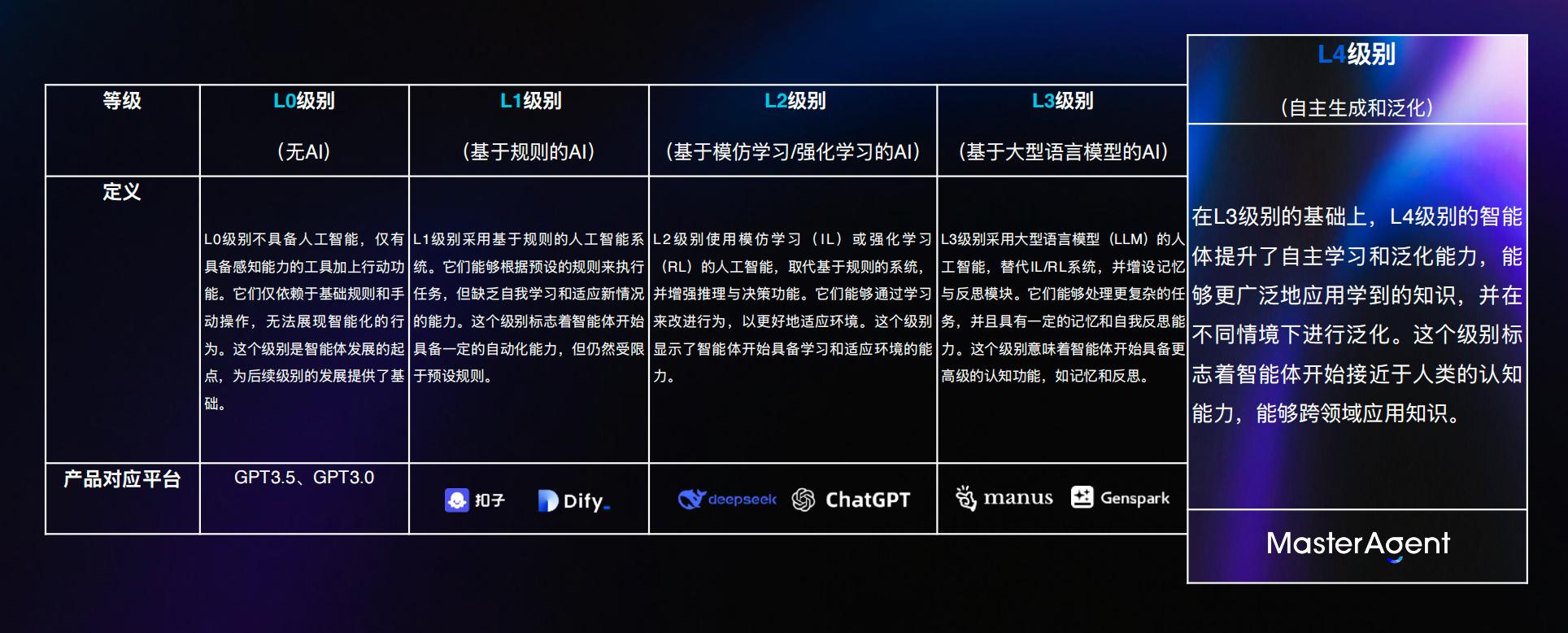
Take MasterAgent as an example. It not only upgrades the agentic programming capability to "generate intelligent agent clusters with one sentence" but, more importantly, possesses capabilities for multi-agent collaborative planning, autonomous perception, dynamic target scheduling, and automatic generation by the super mother system. In simple terms, L4-level intelligent agents can proactively analyze users' target requirements, break down tasks, form teams, and achieve information exchange and collaborative completion. Starting from this point, AI is no longer a "jack-of-all-trades employee" but a "team."
In the real world, there has never been a true "generalist." Superheroes who "conquer the world alone" only exist in movies. A team composed of multiple "versatile elites" is the ideal organization for completing complex tasks.
Precisely because of this, the emergence of MasterAgent holds profound iconic significance in the realm of Agentic AI. As the world's pioneering intelligent agent system to reach Level 4, it marks a groundbreaking evolution, transitioning from 'scheduling intelligent agents' to 'generating intelligent agent teams'. Unlike previous systems, MasterAgent functions akin to an 'intelligent agent mother', autonomously deriving specialized agents tailored to diverse scenarios, constructing task collaboration networks, and executing tasks across multiple industries, spanning content creation, financial investment, medical assistance, government services, and beyond.
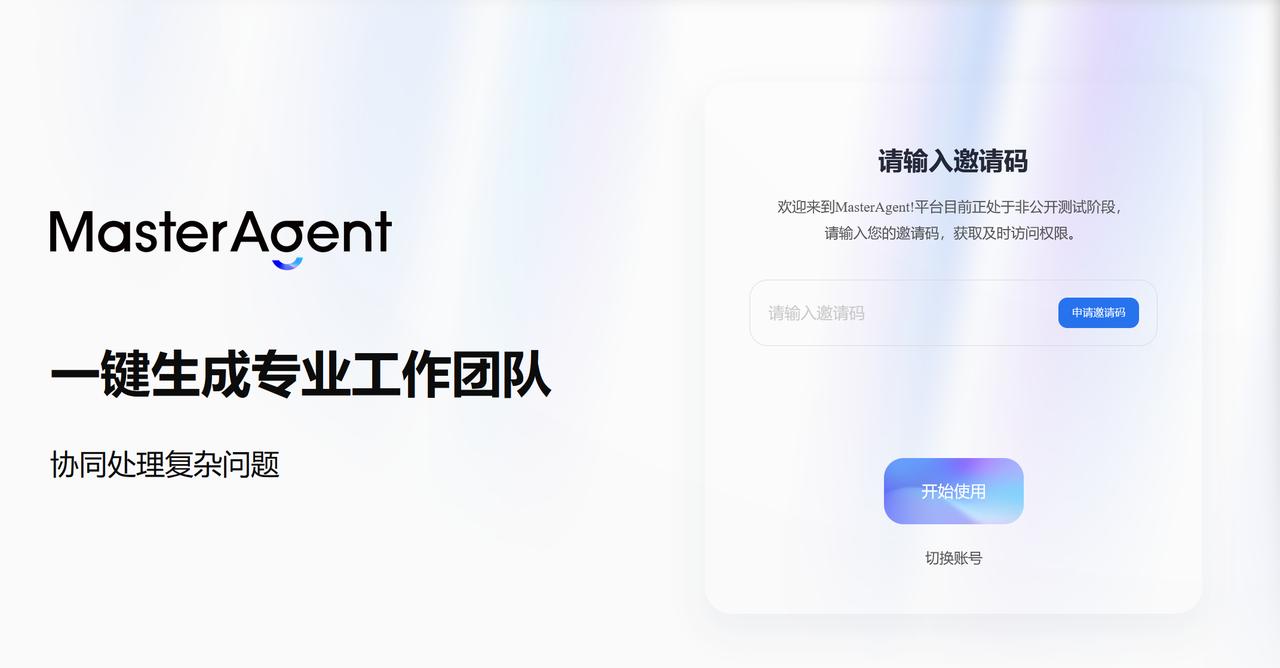
Unlike generic intelligent agents, each agent created by MasterAgent can be customized and modified before being integrated into a super team. This naturally endows them with a 'more professional' edge, better suited to vertical industry scenarios. In contrast to vertical single agents (like text-to-image agents) tailored to specific contexts, MasterAgent can generate multi-agent clusters or standalone agents for any scenario, each possessing autonomous learning and generalization capabilities. Theoretically, they can be synergized to complete any task, underscoring their versatility.
In this light, MasterAgent's advent signifies more than just an enhancement in agency capabilities; it represents a paradigm shift. Level 4 agents, epitomized by MasterAgent, pave the way for AI's penetration into myriad industries, enabling agents to tackle complex real-world tasks and integrating large models seamlessly into production systems.
Today, an unmistakable trend is emerging: all industries must embrace agents. From finance and healthcare to government affairs and education, from enterprise management to public services, any scenario requiring professional decision-making, process execution, and efficient collaboration can significantly boost production efficiency with agents. Any enterprise, organization, or individual must leverage various agents to cut costs, enhance efficiency internally, and generate more commercial value externally, such as enhancing customer experience for enterprises and improving personal work outcomes.
Amidst this accelerated agent penetration, MasterAgent presents an unprecedented opportunity: it not only provides 'agents' but also empowers enterprises, organizations, and individuals to forge an entire team of self-evolving, collaborative, and executing agents.
This marks an upgrade in the AI industry's service model. Responding to diverse intelligent needs, MasterAgent generates agent clusters with professional capabilities tailored to specific tasks, encompassing knowledge systems, behavioral strategies, and memory mechanisms.
For instance, in finance, MasterAgent can spawn virtual roles like analysts, risk controllers, investment advisors, and compliance assistants for investment institutions, collectively tackling tasks like macro research, product recommendations, and compliance verifications. In healthcare, it can simulate roles such as medical record analysts, medical image recognition assistants, drug recommendation systems, and research assistants in hospitals, collaboratively supporting medical experts in diagnostic research.
This implies that agents are no longer mere 'assistants' but rather a 'department'; they do not replace individual links but reshape entire processes. In fact, MasterAgent has preceded generic agents in numerous industries, delving into government affairs, law, finance, healthcare, automotive, and more, refining industry-specific agent solutions for corresponding scenarios based on benchmark applications.

Moreover, MasterAgent is poised to become the central brain of embodied intelligence. Historically, discussions on 'embodied intelligence' or 'humanoid robots' invariably touched upon the AI architecture issue of 'brain-body', but most embodied intelligent systems lacked robust 'brain' coordination. The synergy of MasterAgent and embodied agents assigns agents to different hardware modules and algorithm components, facilitating logical coordination, task decomposition, and priority control, evolving from 'module integration' to 'system intelligence'. This exemplifies MasterAgent's excellence as the matrix of super agents: it is not a single-device upgrade plugin but rather the scheduler, organizer, and leader of the entire intelligent system.
Beyond enterprises and organizations, MasterAgent may usher in even more profound changes for ordinary individuals.
Envision a new media practitioner no longer needing to recruit graphic editors, video editors, or graphic designers but instead constructing a content creation agent team through natural language input via MasterAgent: editorial agents pen articles, directing agents automatically generate video scripts, video editing agents produce footage, image agents invoke tools to create covers, and operational agents manage publishing schedules, channel distribution, and even data reviews—all achievable with a single sentence of natural language. Thus, MasterAgent genuinely amplifies new media practitioners' efficiency, reducing content creation costs, increasing output, and enhancing timeliness.
For lawyers, consultants, independent developers, freelancers, and content creators, this 'one person, one team' model was once a fairy tale. Now, with MasterAgent's support, users need only business understanding and human-specific abilities like 'internet sense' to get started: without programming or recruitment, they can assemble a multi-agent team like building blocks, streamlining, efficientizing, and automating complex tasks.
This is not merely a productivity boost but also a work method revolution. Post the large AI model explosion, more 'one-person companies' have emerged, with renowned AI firms employing far fewer employees than anticipated. For example, Midjourney, an image AIGC company, generated an annual revenue of $500 million with 40 employees; Cal AI, a smart diet company, recorded $12 million in annual revenue with just 4 employees. MasterAgent will undoubtedly popularize elite AI entrepreneurship in the form of 'one-person' or 'few-person' companies. For large organizations with substantial staff, MasterAgent will also significantly reduce costs and enhance efficiency.
In the future, people may no longer inquire 'What can AI do for me?' but simply instruct 'What I want to do.' From this perspective, MasterAgent not only offers enterprises a novel way to embrace AI agents but also opens up symbiotic collaboration possibilities with AI for every individual.








